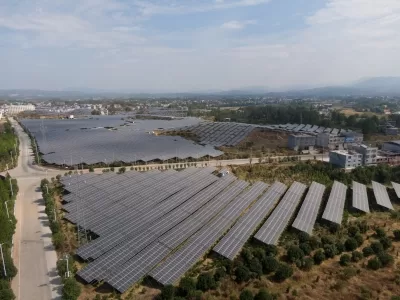In today’s environmentally-conscious world, the shift towards renewable energy sources is paramount in our fight against climate change and reducing our carbon footprint. This article delves into the definitions and examples of renewable resources, their comparison to non-renewable resources, and their overall significance for a sustainable future.

Renewable Resources Definition
What is a Renewable Resource?
Natural resources that can replenish at a rate equal to or faster than their consumption rate are present. These resources, considered sustainable, have a minimal environmental impact compared to non-renewable.
Characteristics of Renewable Resources
Abundance, sustainability, and low environmental impact characterize these resources. By harnessing them through various technologies and practices, we can often contribute to reduced greenhouse gas emissions and a cleaner environment.

Examples of Renewable Resources
Solar Energy
Solar energy captures the sun’s rays to generate electricity or heat. This clean, abundant, and renewable source minimally impacts the environment.
Wind Energy
It converts the kinetic energy from wind into mechanical or electrical energy. Wind turbines harness this renewable resource, which is plentiful and emission-free.
Hydroelectric Power
Harnessing the power of flowing water, typically through dams or run-of-the-river systems, generates hydroelectric power. This reliable and renewable energy source emits minimal greenhouse gases.
Biomass
It refers to organic materials, such as wood, crops, and animal waste, which can be burned or converted into biofuels for energy production. Biomass is considered a renewable resource as long as it is harvested and managed sustainably.
Geothermal Energy
Producing geothermal power involves harnessing the Earth’s internal heat to generate electricity or heat buildings.

Is Water a Renewable Resource?
The Natural Water Cycle
Water is often considered a renewable resource as it is continually replenished through the natural water cycle. However, it is essential to manage water resources sustainably and efficiently to prevent depletion and contamination.
Water Scarcity and Sustainability Concerns
In some regions, water scarcity and over-extraction have led to concerns about the long-term sustainability of this vital resource. Proper management practices and policies must be implemented to ensure water remains a renewable resource for future generations.
Non-Renewable Resources Definition
What are Non-Renewable Resources?
They are those that cannot be replenished within a reasonable timeframe or are finite in quantity. These resources are often extracted from the Earth and consumed at a faster rate than they can be replaced.
Characteristics of Non-Renewable Resources
Non-renewable resources are characterized by their finite nature, slower replenishment rate, and potential for environmental degradation. The extraction and use of them often contribute to greenhouse gas emissions and other forms of pollution.
Examples of Non-Renewable Resources
Fossil Fuels: Coal, Oil, and Natural Gas
Fossil fuels, non-renewable, come from the remains of ancient plants and animals. Coal, oil, and natural gas are used for electricity generation and transportation, but extracting and burning them releases significant greenhouse gases and other pollutants.
Minerals: Uranium, Gold, and Silver
Non-renewable resources like uranium, gold, and silver are extracted from the Earth for various purposes, including energy production and manufacturing. Once depleted, these resources cannot replenish within a reasonable timeframe.

Comparing Renewable and Non-Renewable Resources
Availability and Replenishment Rates
Abundant renewable resources can replenish at a rate equal to or faster than their consumption, making them a sustainable choice for energy production. In contrast, non-renewable resources are finite and deplete faster than they can be replaced.
Environmental Impact
Renewable have a significantly lower environmental impact compared to non-renewable. Harnessing renewable energy sources contributes to reduced greenhouse gas emissions, air pollution, and overall environmental degradation. Non-renewable, on the other hand, often lead to increased emissions, pollution, and other adverse environmental effects.
Economic Factors
Investing in renewable and their associated technologies can lead to long-term economic benefits, including job creation, energy cost savings, and reduced dependence on imported fuels. While non-renewable have historically driven economic growth, their depletion and environmental impact have led to a shift towards sustainable and renewable alternatives.
Conclusion: The Importance of Renewable Resources for a Sustainable Future
Understanding the differences between renewable and non-renewable is crucial in moving towards a more sustainable future. By focusing on renewable, we can reduce our reliance on non-renewable , minimize our environmental impact, and create a cleaner, greener future for generations to come. Investing in renewable energy sources and technologies will not only help combat climate change and preserve the environment, but it will also contribute to long-term economic growth and development.
FAQs
What are the 3 renewable resources?
The three main renewable resources are solar energy, wind energy, and hydropower. These resources are replenished naturally and can be harnessed for electricity generation without depleting them.
Will renewable resources run out?
Renewable resources, by definition, are replenished naturally and continuously. As long as the natural processes that produce these resources continue, they will not run out.
Can renewable resources be replaced?
They are naturally replenished and do not need to be replaced. However, the infrastructure and technology used to harness these resources may need to be replaced or upgraded over time.
Is renewable resources sustainable?
These are generally considered sustainable because they can be harnessed without depleting the resource. However, the sustainability of a specific renewable energy project depends on factors such as the environmental impact of its construction, operation, and maintenance.
Why are renewable resources important?
These resources are important because they provide a sustainable and environmentally friendly alternative to nonrenewable like fossil fuels. They help reduce greenhouse gas emissions, improve air quality, and reduce dependency on finite resources.
How do renewable resources affect the environment?
They have a generally positive impact on the environment, as they produce little to no greenhouse gas emissions and reduce dependency on fossil fuels. However, some renewable energy projects may have local environmental impacts, such as disruption to ecosystems or water resources.
What renewable resource of energy?
Common renewable resources of energy include solar, wind, hydropower, geothermal, and biomass energy. These resources can be harnessed to generate electricity and heat with minimal environmental impact.
Where can you find renewable resources?
Renewable exist worldwide. Sunny regions offer abundant solar energy, while windy areas provide wind energy. Flowing water sources like rivers enable hydropower harnessing. Areas with high geothermal activity contain geothermal energy, and biomass energy comes from organic materials such as plants and waste.
Which renewable source of energy is the best?
There is no one-size-fits-all answer to this question, as the best renewable source of energy depends on local resources, environmental factors, and economic considerations. Each renewable energy source has its own advantages and disadvantages, so the ideal choice depends on the specific situation.
What natural resources are in Canada?
Canada is rich in natural resources, including renewable like hydropower, solar energy, wind energy, and biomass. The country also has abundant nonrenewable resources, such as oil, natural gas, coal, and various minerals like gold, copper, nickel, and uranium.
What renewable energy does the UK use?
The UK uses a mix of renewable energy sources, including wind energy, solar energy, hydropower, and biomass. Wind energy, particularly offshore wind, has seen significant growth in recent years, making it one of the UK’s leading renewable energy sources.
Why are natural resources important?
Natural resources are important because they provide essential materials and energy for human societies. They are crucial for various aspects of life, including food, shelter, transportation, and economic development. Sustainable management of natural resources is vital to ensure their availability for future generations.
Can renewable resources be depleted?
Although renewable resources are naturally replenished, factors such as technology, infrastructure, and environmental considerations may limit the rate of harnessing them. In contrast, nonrenewable resources have a finite supply and can be depleted.
Related Topics
- Solar Power: Solar power converts sunlight to electricity using technologies like photovoltaic (PV) cells or concentrated solar power systems. It is a renewable, clean energy source that reduces reliance on fossil fuels. Solar power fights climate change and provides sustainable energy for homes, businesses, and industries.
- Carbon Dioxide: Carbon dioxide (CO2) is a greenhouse gas released by burning fossil fuels. High CO2 levels cause global warming and climate change. To combat climate change and ensure a sustainable future, we must reduce CO2 emissions by using renewable energy and improving energy efficiency.
- Energy Resources: Energy resources include various power-generating sources. Renewable like solar, wind, hydropower, and biomass offer sustainable alternatives to nonrenewable like coal, oil, and gas. Renewable provide environmental benefits, such as lower greenhouse gas emissions, and promote energy security and diversification.
- Power Grid: The power grid is a network connecting power stations, transformers, and transmission lines to deliver electricity. Integrating renewables into the grid presents challenges and opportunities, including maintaining grid stability, managing renewable energy fluctuations, and creating energy storage solutions. Modernizing grid infrastructure is vital for harnessing renewable energy effectively.
- Carbon Emissions: Carbon emissions are the release of carbon-containing greenhouse gases, mainly CO2, into the atmosphere. Human activities like burning fossil fuels, deforestation, and industrial processes cause these emissions. To fight climate change, meet international goals, and improve air quality, we must reduce carbon emissions by transitioning to renewable energy and adopting energy-efficient practices.
International Renewable Energy Agency (IRENA): https://www.irena.org/